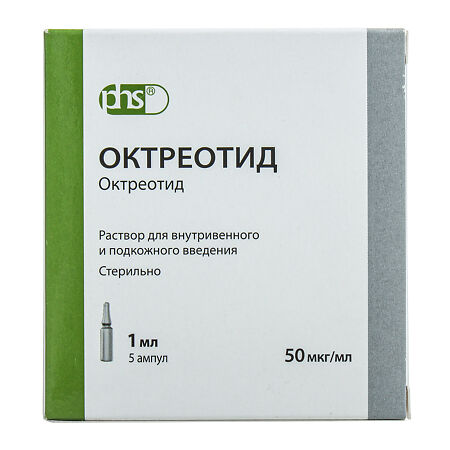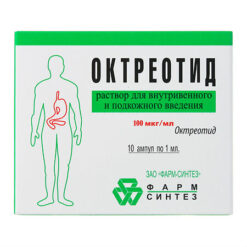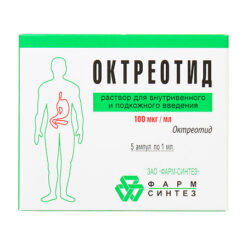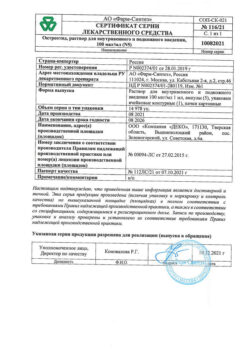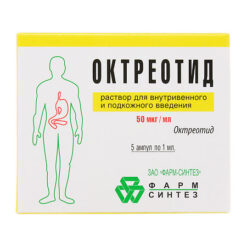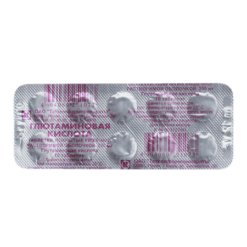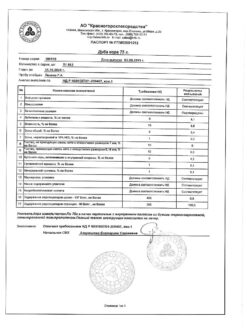No products in the cart.
Octreotide,. 50 µg/ml 1 ml 5 pcs
€1.00
Out of stock
(E-mail when Stock is available)
Description
Pharmacological action
The pharmacological action is somatostatin-like.
Pharmacodynamics
Octreotide is a synthetic analog of somatostatin, which is a derivative of the natural hormone somatostatin and has similar pharmacological effects to it, but significantly longer duration of action.
Octreotide suppresses growth hormone secretion, both pathologically increased and caused by arginine, physical exercise and insulin hypoglycemia. The drug also suppresses insulin, glucagon, gastrin, and serotonin secretion, both pathologically elevated and induced by food intake; it also suppresses arginine-stimulated insulin and glucagon secretion. Octreotide suppresses thyrotropin secretion induced by thyreoliberin.
In contrast to somatostatin, octreotide suppresses growth hormone secretion to a greater extent than insulin secretion, and its administration is not accompanied by subsequent hormone hypersecretion (such as growth hormone in acromegaly patients).
In patients with acromegaly, octreotide reduces plasma concentrations of growth hormone and insulin-like growth factor (IGF-1). Decrease of growth hormone concentration by 50% or more is noted in 90% of patients, and the value of growth hormone concentration of not less than 5 ng/ml is reached in about half of patients. In most patients with acromegaly, octreotide reduces the severity of headache, soft tissue swelling, hyperhidrosis, joint pain and paresthesias. In patients with large pituitary adenomas, treatment with Octreotide may lead to some reduction in tumor size.
In secreting tumors of the gastroenteropancreatic endocrine system in cases of ineffective therapy (surgery, hepatic artery embolization, chemotherapy, including streptozotocin and fluorouracil) administration of Octreotide can lead to improvement of the disease course. For example, in carcinoid tumors, administration of Octreotide may lead to a reduction in the severity of the feeling of blood rush to the face, diarrhea, which in many cases is accompanied by a decrease in plasma serotonin concentration and renal excretion of 5-hydroxyindoleacetic acid.
In tumors characterized by hyperproduction of vasoactive intestinal peptide (VIPOM), use of octreotide leads in most patients to reduction of severe secretory diarrhea and, accordingly, improvement of patient’s quality of life. At the same time there is a reduction of concomitant electrolyte balance disorders, such as hypokalemia, which allows to cancel enteral and parenteral administration of fluids and electrolytes. In some patients the progression of the tumor is slowed or stopped, its size and the size of liver metastases are reduced.
The clinical improvement is usually accompanied by a decrease in plasma concentration of vasoactive intestinal peptide (VIP) or its normalization. In glucagonomas, use of Octreotide results in a reduction of erythema migrans. Octreotide has no significant effect on the severity of hyperglycemia in diabetes mellitus, and the need for insulin or oral hypoglycemic agents usually remains unchanged.
The drug causes a decrease in diarrhea, which is accompanied by an increase in body weight. Although decrease of glucagon concentration in blood plasma under the influence of Octreotide is transient, clinical improvement remains stable during the whole period of using the drug. In patients with gastrinomas/Zollinger-Ellison syndrome when using Octreotide as monotherapy or in combination with proton pump inhibitors or H2-histamine receptor blockers it is possible to decrease hypersecretion of hydrochloric acid in the stomach, decrease of gastrin concentration in blood plasma, and also decrease of diarrhea and hot flashes severity.
In patients with insulinomas octreotide decreases the level of immunoreactive insulin in blood (this effect may be transient, about 2 hours). In patients with operable tumors Octreotide can provide restoration and maintenance of normoglycemia in the preoperative period. In patients with inoperable benign and malignant tumors, glycemic control may improve without a simultaneous prolonged decrease in blood insulin levels.
In patients with rare tumors hyperproducing the growth hormone releasing factor (somatoliberinomas), octreotide reduces the severity of acromegaly symptoms. This is due to the suppression of growth hormone releasing factor and growth hormone secretion itself. Subsequently, hypertrophy of the pituitary gland may decrease.
In bleeding from esophageal and gastric varices in cirrhotic patients, the use of octreotide in combination with specific treatments (e.g., sclerosing therapy) leads to more effective bleeding arrest and early rebleeding, reduced transfusion volume and improved 5-day survival. The mechanism of action of octreotide is thought to be related to reduction of organ blood flow through suppression of vasoactive hormones such as VIP and glucagon.
Pharmacokinetics
Intake
After oral administration, octreotide is rapidly and completely absorbed. Tmax of octreotide in plasma is reached within 30 min.
Distribution
The binding to plasma proteins is 65%. The binding of octreotide with blood cells is extremely insignificant. Vd is 0.27 l/kg.
Evolution
The T1/2 after p/c administration of Octreotide is 100 min. After IV administration, excretion of Octreotide occurs in 2 phases, with a T1/2 of 10 and 90 min, respectively. Most of octreotide is excreted through the intestine, about 32% is excreted unchanged by the kidneys. Total clearance is 160 ml/min.
Indications
Indications
Stopping bleeding from esophageal and gastric varices in patients with cirrhosis and prevention of recurrence (in combination with endoscopic sclerosing therapy or other specific therapeutic measures);
Acromegaly/p>
Acromegaly – to control disease symptoms and reduce insulin-like growth factor-1 (IGF-1) and plasma growth hormone in cases where the effect of radiation or surgical treatment is insufficient;
To treat the disease when the patient has refused surgery or has a contraindication to surgery. For short-term treatment in the intervals between courses of radiotherapy until the effect of radiation therapy is achieved;
Secreting endocrine tumors of the pancreas and gastrointestinal tract (for symptom control): Glucagonomas, somatoliberinomas, VIPomas, carcinoid tumors with carcinoid syndrome, insulinomas (for maintenance therapy and also to control preoperative hypoglycemia), gastrinomas and Zollinger-Ellison syndrome (usually in combination with histamine H2-receptor blockers and proton pump inhibitors);
The treatment of acute pancreatitis;
The treatment and prevention of complications after abdominal surgery;
Stopping bleeding in peptic ulcer disease of the stomach and 12 duodenum.
Active ingredient
Active ingredient
How to take, the dosage
How to take, the dosage
P/k, IV drops.
In acromegaly, the dose is p/c, 300 mcg at 8 or 12-hour intervals. This dose is used if initial therapy is ineffective (Octreotide, solution for intravenous and intravenous injection, 50-100 mcg at 8 or 12-hour intervals).
The ineffectiveness of initial therapy is evaluated based on monthly blood concentrations of growth hormone (target concentration: growth hormone <2.5 ng/ml; IGF-1 is within normal limits), analysis of clinical symptoms and tolerability of the drug. If the 300 µg dose is ineffective, it is recommended to adjust the dose based on the above criteria. The maximum dose of 1500 mcg/day should not be exceeded.
In patients receiving octreotide at a stable dose, the growth hormone concentration should be determined every 6 months. If after 3 months of treatment with Octreotide there is no sufficient decrease of growth hormone concentration and improvement of clinical picture of the disease, the therapy should be stopped.
In tumors of the gastroenteropancreatic endocrine system – p/c, in a dose of 300 mcg 1-2 times a day. This dose is used if the initial therapy is ineffective (Octreotide, solution for intravenous and intravenous administration, 50 mcg 1-2 times a day with gradual increase up to 100-200 mcg 3 times a day).
The ineffectiveness of the initial therapy is evaluated based on the achieved clinical effect, the effect on the concentration of hormones produced by the tumor (in the case of carcinoid tumors – the effect on renal excretion of 5-hydroxyindoleacetic acid) and tolerability. In exceptional cases it is allowed to prescribe the patient a dose exceeding 600 mcg/day, the drug dose can be gradually increased to 300-600 mcg 3 times a day. Maintenance doses of the drug should be selected individually. In carcinoid tumors, if therapy with octreotide in the maximum tolerated dose for 1 week has not been effective, treatment should not be continued.
In case of bleeding from variceal veins of the esophagus and stomach, by IV drip, at a rate of 25 mcg/h for 5 days.
Particular patient groups
There is currently no evidence to suggest that the tolerability of octreotide is reduced in the elderly and a change in dosing regimen is required for them.
Adjustment of the maintenance dose in patients with impaired liver function is recommended.
In patients with impaired renal function no dosing adjustments for octreotide are required.
The experience with octreotide in children is limited.
Rules for use of the drug
Pharmonic administration. Patients who self-administer octreotide b/c should get detailed instructions from their physician or nurse. The solution should be warmed to room temperature before injection to reduce discomfort at the injection site. The drug should not be injected into the same place at short intervals. Ampoules should be opened immediately before injecting; the unused amount of solution should be discarded.
Intravenous drip administration. If it is necessary to administer Octreotide by IV drip injection, the contents of one ampoule containing 600 µg of the active substance should be diluted in 60 ml of 0.9% sodium chloride solution. Octreotide remains physically and chemically stable in sterile 0.9% sodium chloride solution or 5% dextrose solution in water at temperatures below 25°C for 24 h.
However, since octreotide may affect glucose metabolism, it is preferable to use 0.9% sodium chloride solution. Before IV administration, the ampoule should be carefully inspected for discoloration of the solution and the presence of foreign particles.
In order to avoid microbial contamination, diluted solutions should be used immediately after preparation. If the solution will not be used immediately, it should be stored at 2-8 °C. The solution should be warmed to room temperature before administration.
The total time between dilution, storage in the refrigerator and completion of solution administration should not exceed 24 hours.
Interaction
Interaction
Pharmacokinetic
It reduces absorption of cyclosporine, slows down absorption of cimetidine. Dosing regimen of concomitantly used diuretics, beta-adrenoblockers, BCCs, oral hypoglycemic agents, glucagon must be corrected.
The combined use of octreotide and bromocriptine increases the bioavailability of bromocriptine.
Decreases the metabolism of substances metabolized with the participation of cytochrome P450 system enzymes (may be due to inhibition of growth hormone).
Because these effects of Octreotide cannot be excluded, caution should be exercised when prescribing drugs that are metabolized by the cytochrome P450 system and have a narrow range of therapeutic concentrations (e.g. quinidine, terfenadine).
Special Instructions
Special Instructions
In pituitary tumors secreting growth hormone, patients receiving octreotide should be closely monitored, as tumors may increase in size and develop serious complications such as narrowing of the visual fields. In these cases other treatment options should be considered.
Because a decrease in growth hormone levels and normalization of IGF-1 levels with octreotide therapy may lead to restoration of fertility in women with acromegaly, patients of childbearing age should use reliable contraception when using the drug.
If Octreotide is prescribed for a long period of time, thyroid function should be monitored.
If bradycardia develops with octreotide, doses of beta-adrenoblockers, BCCs or drugs affecting the water-electrolyte balance may be reduced if necessary.
In some patients octreotide may alter absorption of fats in the intestine.
With the use of Octreotide there was a decrease in cobalamin (vitamin B12) and deviations from normal values of cobalamin absorption test (Schilling test).
When using Octreotide in patients with a history of vitamin B12 deficiency it is recommended to monitor cobalamin levels in the body.
Management recommendations for patients during treatment with Octreotide regarding gallstone formation:
– Patients should have an initial gallbladder ultrasound before prescribing Octreotide;
– Repeated gallbladder ultrasounds should be performed during treatment with Octreotide, preferably at 6-12 month intervals;
If gallstones are detected before treatment begins, the potential benefits of Octreotide therapy should be evaluated against the possible risks associated with their presence. There is no evidence of any adverse effect of octreotide on the course or prognosis of pre-existing gallstone disease.
Management of patients in whom gallstones form during treatment with Octreotide:
– asymptomatic gallstones.
The use of Octreotide can be discontinued or continued – according to a benefit/risk assessment. In either case, there is no need to do anything other than to continue monitoring, making it more frequent if necessary;
– gallstones with clinical symptoms.
The use of octreotide can be discontinued or continued, according to a benefit/risk assessment. In any case the patient should be treated as in other cases of gallstone disease with clinical manifestations. Medical treatment includes the use of combinations of bile acids (for example, chenodeoxycholic acid at a dose of 7.5 mg/kg/day in combination with ursodeoxycholic acid at the same dose) with ultrasound monitoring until the stones have completely disappeared.
In treatment of endocrine tumors of the gastrointestinal tract and pancreas with Octreotide in rare cases a sudden relapse of the disease symptoms may occur. In patients with insulinomas during treatment with Octreotide an increase in severity and duration of hypoglycemia may be observed (this is associated with a more pronounced suppressive effect on growth hormone and glucagon secretion than on insulin secretion, as well as with a shorter duration of inhibitory effect on insulin secretion).
These patients should be closely monitored regularly, both at the start of treatment with Octreotide and each time the dose of the drug is changed.
Significant fluctuations in blood glucose concentrations may be attempted to be reduced by administering Octreotide more frequently at lower doses. In patients with type 1 diabetes, octreotide may reduce the need for insulin.
In patients without diabetes and with type 2 diabetes, when insulin secretion is partially preserved, administration of Octreotide may result in postprandial hyperglycemia. When using Octreotide in patients with diabetes mellitus, blood glucose concentration control and antidiabetic therapy are recommended.
Because there is an increased risk of developing type 1 diabetes after bleeding from esophageal and gastric varices, and patients with diabetes may also have changes in insulin requirements, systematic monitoring of blood glucose concentrations is necessary in these cases.
The dosing regimen of concomitantly used diuretics, beta-adrenoblockers, BKK, insulin, oral hypoglycemic agents, and glucagon must be corrected.
Impact on the ability to drive vehicles and other mechanisms.
Some side effects of Octreotide may adversely affect the ability to drive vehicles and other mechanisms requiring increased concentration, speed and speed of psychomotor reactions. In this regard, it is recommended to exercise caution when driving vehicles or operating machinery requiring increased concentration in case of the appearance of the corresponding symptoms.
Contraindications
Contraindications
Hypersensitivity to octreotide or other components of the drug;
Children under 18 years of age.
With caution: cholelithiasis (gallstone disease); diabetes mellitus.
Side effects
Side effects
The main adverse events observed during the use of Octreotide were adverse effects of the digestive, nervous, hepatobiliary systems, as well as metabolic disorders and the development of nutritional deficiencies.
In clinical trials, the most common side effects observed when the drug was prescribed were diarrhea, abdominal pain, nausea, bloating, headache, gallstones formation, hyperglycemia, and constipation.
Dizziness, pain of various localizations, impaired colloidal stability of bile (formation of cholesterol microcrystals), thyroid dysfunction (reduced levels of thyroid hormone, total and free thyroxine), soft stool consistency, reduced glucose tolerance, vomiting, asthenia and hypoglycemia were also frequently observed.
In rare cases when using the drug, phenomena resembling acute intestinal obstruction may be observed: progressive abdominal bloating, marked pain in the epigastric region, abdominal wall tension, muscle “protection”.
While fecal fat excretion may increase, to date there is no evidence that long-term treatment with octreotide may result in nutritional deficiencies due to malabsorption (malabsorption). Very rare cases of acute pancreatitis have been reported, developing in the first hours or days of p/c use of Octreotide and disappearing after discontinuation of the drug. In addition, cases of pancreatitis associated with cholelithiasis have been reported with long-term use of Octreotide p/c.
According to ECG study data, prolongation of QT interval, deviation of cardiac electrical axis, early repolarization, low voltage ECG type, transient shift, early P wave and nonspecific changes of ST segment and T tooth were observed in patients with acromegaly and carcinoid syndrome against the background of using the drug.
Because this category of patients has heart disease, a causal relationship between the use of Octreotide and the development of these adverse events has not been established.
The following criteria were used to determine the frequency of adverse reactions identified during clinical trials of the drug: very common (â¥1/10); common (â¥1/100, <1/10); sometimes (â¥1/1000, <1/100); rare (â¥1/10000, <1/1000); very rare (<1/10000), including individual reports.
Digestive system disorders: very common – diarrhea, abdominal pain, nausea, constipation, abdominal bloating; common – dyspeptic disorders, vomiting, feeling of fullness/stiffness of the stomach, steatorrhea, soft stool consistency, changed stool color, anorexia.
Nervous system disorders: very often – headache; often – dizziness.
Endocrine system: very common – hyperglycemia; common – hypothyroidism/disorders of thyroid function (decreased levels of TSH, total and free thyroxine); hypoglycemia, impaired glucose tolerance.
Hepatobiliary system disorders: very common – cholelithiasis, i.e., gallstones formation; common – cholecystitis, disorders of colloidal stability of bile (formation of cholesterol microcrystals), hyperbilirubinemia, increased activity of liver transaminases.
Dermatological reactions: often – itching, rash, hair loss.
Respiratory system: often – shortness of breath.
System: often – bradycardia; sometimes – tachycardia.
General disorders and reactions at the injection site: very often – pain at the injection site; sometimes – dehydration.
The following adverse events have been noted in clinical practice during therapy with Octreotide regardless of any causal relationship to the use of the drug.
Immune system disorders: anaphylactic reactions, allergic reactions/hypersensitivity.
Dermatological reactions: urticaria.
Hepatobiliary system disorders: acute pancreatitis, acute hepatitis without signs of cholestasis, cholestatic hepatitis, cholestasis, jaundice, cholestatic jaundice, increased levels of ALP, GGT.
Systemic reactions: arrhythmia.
Overdose
Overdose
Some cases of octreotide overdose in children and adults have been reported in clinical practice. When octreotide was accidentally administered in adults at a dose of 2400-6000 mcg/day, administered by IV drip (infusion rate 100-250 mcg/h) or p/c (1500 mcg 3 times a day), the following were observed: development of arrhythmias, BP decrease, sudden cardiac arrest, brain hypoxia, pancreatitis, fatty liver degeneration, diarrhea, weakness, retardation, weight loss, hepatomegaly and lactate acidosis.
In incidental administration of Octreotide in children at a dose of 50-3000 mcg/day administered by IV drip (infusion rate 2.1-500 mcg/h) or p/c (50-100 mcg), only moderate hyperglycemia was observed.
No new adverse events (other than those noted in the side effects section) have been observed in patients with tumors when octreotide is administered p/c at a dose of 3000-30000 mcg/day (divided into multiple infusions).
Similarities
Similarities
Additional information
| Manufacturer | Pharmstandard-Leksredstva, Russia |
|---|---|
| Medication form | solution |
| Brand | Pharmstandard-Leksredstva |
Other forms…
Related products
Buy Octreotide,. 50 µg/ml 1 ml 5 pcs with delivery to USA, UK, Europe and over 120 other countries.

